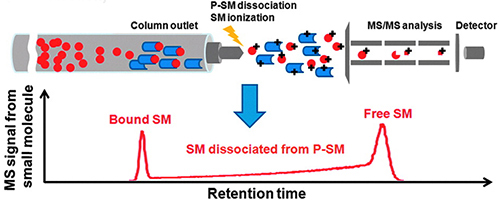Anton Simeonov Ph.D. National Institute of Health
Find Out How KSEC-MS Separates Small Molecules from any Protein–Small Molecule Complex
The quest to develop even-simpler platforms for interrogation of protein–small molecule interactions continues. Despite dramatic advances in surface plasmon resonance and related techniques, the need still remains for approaches that do not require surface immobilization of proteins because this step has remained the most difficult aspect of such experiments. Here, the authors* provide a simple chromatography-based technique, coupled with novel data analysis, which allows the derivation of binding kinetics of small molecules interacting with proteins. In size-exclusion chromatography, an unbound small molecule travels slowly, eluting from the column last (together with salts, dyes, and/or other small molecule buffer components of the injected sample), while a fully bound ligand is expected to elute relatively fast as a part of its complex with the protein of interest (exact elution time of the latter depending on the molecular weight of the protein). The authors* recognized that between these extreme cases lies the typical situation in which given certain kon and koff of the complex, during migration through the size-exclusion column, the small molecule is likely to dissociate from the complex gradually and to begin to lag behind the protein, thus creating a specific profile of its concentration as a function of elution volume. The team used mass spectrometry for detection and quantitation of the small molecule in order to construct the profile (see figure) and then applied a series of equations to derive the kinetics of interaction. Data obtained from this method, which entails only injecting the complex and following the small molecule through mass spectrometry detector, compared favorably with results obtained through traditional means. The extreme simplicity of this new approach should make it an attractive alternative, especially in cases where the protein to be immobilized displays extreme sensitivity to such treatment.
Conceptual depiction of ppKSEC-MS. (A) The small molecule, SM, and protein, P, are sequentially injected into a SEC column separated by a spacer of the buffer (t0). P moves faster than SM, and then, P meets SM; they can bind each other forming complex P–SM (t1). After P and P–SM leave the zone of SM (t2), P–SM starts dissociating. The released SM is continuously separated from P–SM and creates a bridge between the zones of P/P–SM and SM (t3). The graph illustrates the corresponding concentrations of P, SM, and P–SM at time t3. (B) The eluate from the column is continuously sampled into the ion source of a tandem MS/MS mass spectrometer, which is tuned to detect SM. The blue rods represent P while the red dots represent SM. SM dissociates to form P–SM, which facilitates indirect detection of intact P–SM exiting the column. The resulting ppKSEC-MS chromatogram contains two peaks and a bridge between them. (C) The experimental ppKSEC-MS chromatogram is numerically fitted with a computer-simulated one. The values of kon and koff are used as fitting parameters, and the best fit corresponds to the sought correct values of kon and koff.

* Abstract from Anal Chem 2014, Vol. 86:10016–10020
Studying the kinetics of reversible protein–small molecule binding is a major challenge. The available approaches require that either the small molecule or the protein be modified by labeling or immobilization on a surface. Not only can such modifications be difficult to do but also they can drastically affect the kinetic parameters of the interaction. To solve this problem, we present kinetic size-exclusion chromatography with mass spectrometry detection (KSECMS), a solution-based label-free approach. KSEC-MS utilizes the ability of size-exclusion chromatography (SEC) to separate any small molecule from any protein–small molecule complex without immobilization and the ability of mass spectrometry (MS) to detect a small molecule without a label. The rate constants of complex formation and dissociation are deconvoluted from the temporal pattern of small molecule elution measured with MS at the exit from the SEC column. This work describes the concept of KSEC-MS and proves it in principle by measuring the rate constants of interaction between carbonic anhydrase and acetazolamide.
ASSAY & Drug Development Technologies, published by Mary Ann Liebert, Inc., offers a unique combination of original research and reports on the techniques and tools being used in cutting-edge drug development. The journal includes a "Literature Search and Review" column that identifies published papers of note and discusses their importance. GEN presents here one article that was analyzed in the "Literature Search and Review" column, a paper published in Analytical Chemistry titled "Kinetic size-exclusion chromatography with mass spectrometry detection: an approach for solution-based label-free kinetic analysis of protein–small molecule interactions." Authors of the paper are Bao J, Krylova SM, Cherney LT, LeBlanc JC, Pribil P, Johnson PE, Wilson DJ, Krylov SN
Anton Simeoniv works at the NIH.



